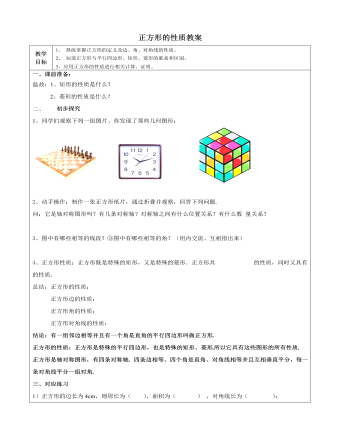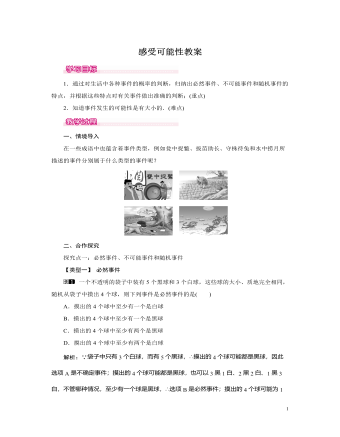-

北师大初中数学九年级上册反比例函数的性质1教案
如图,四边形OABC是边长为1的正方形,反比例函数y=kx的图象经过点B(x0,y0),则k的值为.解析:∵四边形OABC是边长为1的正方形,∴它的面积为1,且BA⊥y轴.又∵点B(x0,y0)是反比例函数y=kx图象上的一点,则有S正方形OABC=|x0y0|=|k|,即1=|k|.∴k=±1.又∵点B在第二象限,∴k=-1.方法总结:利用正方形或矩形或三角形的面积确定|k|的值之后,要注意根据函数图象所在位置或函数的增减性确定k的符号.三、板书设计反比例函数的性质性质当k>0时,在每一象限内,y的值随x的值的增大而减小当k<0时,在每一象限内,y的值随x的值的增大而增大反比例函数图象中比例系数k的几何意义通过对反比例函数图象的全面观察和比较,发现函数自身的规律,概括反比例函数的有关性质,进行语言表述,训练学生的概括、总结能力,在相互交流中发展从图象中获取信息的能力.让学生积极参与到数学学习活动中,增强他们对数学学习的好奇心与求知欲.

北师大初中数学九年级上册正方形的性质2教案
1)正方形的边长为4cm,则周长为( ),面积为( ) ,对角线长为( );2))正方形ABCD中,对角线AC、BD交于O点,AC=4 cm,则正方形的边长为( ), 周长为( ),面积为( )3)在正方形ABCD中,AB=12 cm,对角线AC、BD相交于O,OA= ,AC= 。4) 1、正方形具有而矩形不一定具有的性质是( ) A、四个角相等 B、对角线互相垂直平分 C、对角互补 D、对角线相等. 5)、正方形具有而菱形不一定具有的性质( ) A、四条边相等 B对角线互相垂直平分 C对角线平分一组对角 D对角线相等. 6)、正方形对角线长6,则它的面积为_________ ,周长为________. 7)、顺次连接正方形各边中点的小正方形的面积是原正方形面积的( )A.1/2 B.1/3 C.1/4 D.1/ 5四:范例讲解:1、(课本P21例1)学生自己阅读课本内容、注意证明过程的书写2、 如图,分别以△ABC的边AB,AC为一边向外画正方形AEDB和正方形ACFG,连接CE,BG.求证:BG=CE

北师大初中数学九年级上册正方形的性质1教案
在Rt△ABC中,AC=AB2+BC2=12+12=2(cm),∴FC=AC-AF=2-1(cm),∴BE=2-1(cm).方法总结:正方形被对角线分成4个等腰直角三角形,因此在正方形中解决问题时常用到等腰三角形的性质与直角三角形的性质.【类型三】 利用正方形的性质证明线段相等如图,已知过正方形ABCD的对角线BD上一点P,作PE⊥BC于点E,PF⊥CD于点F,求证:AP=EF.解析:由PE⊥BC,PF⊥CD知四边形PECF为矩形,故有EF=PC,这时只需说明AP=CP,由正方形对角线互相垂直平分可知AP=CP.证明:连接AC,PC,如图.∵四边形ABCD为正方形,∴BD垂直平分AC,∴AP=CP.∵PE⊥BC,PF⊥CD,∠BCD=90°,∴四边形PECF为矩形,∴PC=EF,∴AP=EF.方法总结:(1)在正方形中,常利用对角线互相垂直平分证明线段相等;(2)无论是正方形还是矩形,经常连接对角线,这样可以使分散的条件集中.

小学科学教科版四年级上册《保护我们的听力》教案
过程与方法:通过阅读保护听力的资料,了解我们的听力经常受到哪些伤害,知道保护听力的做法。情感、态度、价值观:认识到保护听力的重要性,养成良好的用耳习惯和在公共场所保持肃静的习惯。教学重点认识到保护听力的重要性教学难点知道各种控制噪音的方法教学准备发音罐、报纸、毛巾、棉花等

北师大初中七年级数学下册平行线的性质教案
解析:平行线中的拐点问题,通常需过拐点作平行线.解:(1)∠AED=∠BAE+∠CDE.理由如下:过点E作EG∥AB.∵AB∥CD,∴AB∥EG∥CD,∴∠AEG=∠BAE,∠DEG=∠CDE.∵∠AED=∠AEG+∠DEG,∴∠AED=∠BAE+∠CDE;(2)同(1)可得∠AFD=∠BAF+∠CDF.∵∠BAF=2∠EAF,∠CDF=2∠EDF,∴∠BAE+∠CDE=32∠BAF+32∠CDF,∴∠AED=32∠AFD.方法总结:无论平行线中的何种问题,都可转化到基本模型中去解决,把复杂的问题分解到简单模型中,问题便迎刃而解.三、板书设计平行线的性质:性质1:两条平行线被第三条直线所截,同位角相等;性质2:两条平行线被第三条直线所截,内错角相等;性质3:两条平行线被第三条直线所截,同旁内角互补.平行线的性质是几何证明的基础,教学中注意基本的推理格式的书写,培养学生的逻辑思维能力,鼓励学生勇于尝试.在课堂上,力求体现学生的主体地位,把课堂交给学生,让学生在动口、动手、动脑中学数学

北师大初中七年级数学下册感受可能性教案
一个不透明的袋子中装有5个黑球和3个白球,这些球的大小、质地完全相同,随机从袋子中摸出4个球,则下列事件是必然事件的是( )A.摸出的4个球中至少有一个是白球B.摸出的4个球中至少有一个是黑球C.摸出的4个球中至少有两个是黑球D.摸出的4个球中至少有两个是白球解析:∵袋子中只有3个白球,而有5个黑球,∴摸出的4个球可能都是黑球,因此选项A是不确定事件;摸出的4个球可能都是黑球,也可以3黑1白、2黑2白、1黑3白,不管哪种情况,至少有一个球是黑球,∴选项B是必然事件;摸出的4个球可能为1黑3白,∴选项C是不确定事件;摸出的4个球可能都是黑球或1白3黑,∴选项D是不确定事件.故选B.方法总结:事件类型的判断首先要判断该事件发生与否是不是确定的.若是确定的,再判断其是必然发生的(必然事件),还是必然不发生的(不可能事件).若是不确定的,则该事件是不确定事件.

北师大初中七年级数学下册频率的稳定性教案
解析:(1)根据表中信息,用优等品频数m除以抽取的篮球数n即可;(2)根据表中数据,优等品频率为0.94,0.95,0.93,0.94,0.94,稳定在0.94左右,即可估计这批篮球优等品的概率.解:(1)570600=0.95,744800=0.93,9401000=0.94,11281200=0.94,故表中依次填0.95,0.93,0.94,0.94; (2)这批篮球优等品的概率估计值是0.94.三、板书设计1.频率及其稳定性:在大量重复试验的情况下,事件的频率会呈现稳定性,即频率会在一个常数附近摆动.随着试验次数的增加,摆动的幅度有越来越小的趋势.2.用频率估计概率:一般地,在大量重复实验下,随机事件A发生的频率会稳定到某一个常数p,于是,我们用p这个常数表示随机事件A发生的概率,即P(A)=p.教学过程中,学生通过对比频率与概率的区别,体会到两者间的联系,从而运用其解决实际生活中遇到的问题,使学生感受到数学与生活的紧密联系

人教版新课标小学数学五年级下册设计镶嵌图案教案
师:同学们,在四年级的时候,我们已经了解了图形的密铺,请你说一说,什么是图形的密铺?(没有重叠、没有空隙地铺在平面上,就是密铺。)师:图形的密铺又可以叫做镶嵌,以上四个图片,都是由哪些基本图形密铺(镶嵌)而成的呢?(请学生边指边说。)师:还有哪些图形也可以镶嵌?(学生可能回答:三角形,平行四边形,梯形,菱形,正六边形,……)师:今天就请你发挥一下想象力,设计一些与众不同的镶嵌图形。[设计意图说明:学生在四年级已经初步了解了图形的密铺(镶嵌)现象,四幅图片是四年级下册教材《三角形》单元中《密铺》内容中的原图。本单元在此基础上,通过数学游戏拓展镶嵌图形的范围,让学生用图形变换设计镶嵌图案,进一步感受图形变换带来的美感以及在生活中的应用。]二、新授探究一:利用平移变换设计镶嵌图形

人教版新课标小学数学五年级下册数学广角教案
教学要求1. 通过生活中的事例,学会解决“找次品”这类问题的思想方法。2. 体会解决问题策略的多样性及运用优化的方法解决问题的有效性。3. 感受到数学在日常生活中的广泛应用,培养应用意识和解决实际问题的能力。学情分析有化是一种重要的数学思想方法,可有效地分析和解决问题。本单元主要以“找次品”这一操作活动为载体,让学生通过观察、猜测、推理的方法感受解决问题策略的多样性,在此基础上,通过归纳、推理的方法体会运用优化策略解决问题的有效性,感受数学的魅力。这些内容对五年级的学生来说有一定的难度,所以应让学生在具体操作和试验中感悟、体会,由此使学生养成勤于思考、勇于探索的精神。教学重点学会解决“找次品”这类问题的方法。

二年级数学下册第十单元总复习教案
1、复习万以内数的认识。 请同学们先来回忆一下,我们学了万以内数的哪些知识? 回忆学了万以内数的数数、读数、写数、数的组成、数位的含义、数的顺序和大小比较、近似数以及整百、整千数的加减法……2、下面先请大家独立做教材第3题,然后集体订正。 指名让学生说一说是怎么做的?3、写一写,再读一读。① 千位上是2个千、百位上是5个百、个位上是6个一。② 二千五百零六。4、 下面复习用计数单位表示数,独立完成书上第4题,想一想是怎样做出来的。5、 复习近似数。请同学们看教材第5题,找出这段文字中哪些数是近似数?并画出来。再请同学回答。

人教版新目标初中英语七年级下册Where is your pen pal from教案
2.1Match the country with the language.Step II Reading3a? let the students read the letter fast and answer the questions.? Let the students ask more questions about the letter as possible as the can.Step III Writing3b.Step IV. Pairwork2cStep V Listening2a, 2bStep V. HomeworkExercises book(1) P3Exercises book (2) P3Period FourStep I . Dictate the words and sentences in Unit1.Step II. Self-checkStep III. Check the answers for Exercises book in the unit.Step IV. Home workRevise and preparation for unit 2.教学反思:通过本单元的学习,学生基本可以谈论人们的国籍,居住城市及其所说的语言,通过书信方式去介绍自己并寻找笔友。但在涉及到国外的一些城市时,学生对这方面的知识相对欠缺,能介绍的城市并不多,也反应出学生课前预习不充分,这跟学生学习条件也有关,大多数学生无法通过网络获取所需信息。因此,在以后的教学中要多指导学生通过计算机网络获取信息,拓宽知识面。

人教版新目标初中英语七年级下册What does he look like教案3篇
所需要用到的句子:Who is that?That is Jack. I like him.Why do you like him?I like him because he is interesting.Task 4: 设计理想中的人类Step one: 设计理想中的人类的外貌。把全班同学分成若干小组,学生可以边说边在纸上画出他们的模样。Step two: 设计理想中人类的性格。学生们可以把那些能描述性格的单词写在图画的旁边。Step three: 每组选出一名同学,其他同组同学提问,他作简单回答,并说明原因。所需用到的句子:What does he or she look like?He or she ...What is he or she like?He or she is ...Why?Because ...Task 5: 挑战性活动调查性格是天生的还是后天形成的,让每个同学回家去调查一下自己成长过程中性格是否有变化,具体是怎样的,为什么会这样? Teaching Aims:1. Enable students to have a general understanding of how to talk about people's physical appearance.2. Enable students to tackle some essential vocabularies and patterns about describing people. Provide them with necessary skills and methods.3. Create various chances for students to describe the persons they're familiar with, such as classmates, family members, teachers, idols, etc.

人教版新目标初中英语七年级下册Where is the post office教案2篇
Period 2 (3a----Section B 2c)Preview(Pre-task): Key points: What laAdd another information about their pen pals----their language on the cardnguage does she/he speak?She/He speaks....Does she/he have any brothers and sisters? Does she/he speak English?Preview(Pre-task): Add another information about their pen pals----their language on the cardKey points: What language does she/he speak?She/He speaks....Does she/he have any brothers and sisters? Does she/he speak English?Step 1 Revision1.Revisionand dictation of the new words 2.Revise the drills they learned yesterday.(by pairwork and grammar exercise)Step 2 Leading-inT has a conversation with one student. The conversation is following:---Do you have a pen pal?---Yes, I do.---What's your pen pal's name? ---His/Her name is....---Where is your pen pal from? ---He/She is from...---Where does he/she live? ---He/She lives in....---What language does he/she speak?He/She speaks...Write the new words on the Bb. They are following: EnglishChineseJapaneseFrenchStep 3 LearnLearn the new words with the whole class.Finish 3a with the students3b Pairwork T still does an example with one student Then the Ss practise in pairs. The example is following:--Curry Muray is my pen pal. He is from the United States.---What language does he speak?

人教版新目标初中英语七年级下册Don’t eat in class教案2篇
Don’t fight. =You can’t fight. (板书,教读)教师把这些句子板书在黑板上,并请学生大声整齐地读祈使句和“can’t”句型,并让学生注意两种句型表达形式的不同和转换,“Don’t …=You can’t…”;并对学生说:These are our school rules. (板书,教读) You can’t break the school rules. Don’t break the school rules.(板书,教读)步骤3 :Practicea. T: Now, each of the students is breaking one of these rules.Please finish 1a.学生看图,完成1a的内容,检查答案并大声朗读校规。b. 听录音,完成1b,选出四位学生都违反了哪条校规;听之前,学生要读会英文名。c. 请两位学生朗读1c部分的句型;要求学生两人一组对话表演,SA扮演外校转来新生,SB告知本校校规。(学生可经过讨论,多说出他们想到的校规,不必只限于书上;教师应给予帮助)2) 第二课时(2a~4)步骤1 :warming up of revisionT: What are the rules at your school?学生使用“can”或祈使句表达各条校规;其中老师可引出“eat in the cafeteria outside”的表达。步骤2 :Practicea.T: Christina is an exchange student. She doesn’t know the rules. Let’s listen, what activities they’re talking about?学生听第一遍时,完成2a;第二遍时,完成2b;b. 请学生领读2c部分,看着2a完成的表格,理解2c活动的要求;分成小组针对2a进行问答;

人教版新目标初中英语七年级下册I ’d like some noodles教案
教学过程Step 1: warming-up Sing a song---------“food and drink” Step 2: Revision1 Dictation2 Revise: What kind of noodles would you like?I’d like …What size bowl of noodles would you like?I’d like…Step 3: Presentation1 show pictures of food, ask students say the words.2 Students read the newspaper ad in 3a. Fill in blanks with words in the box. Then read the ad together, the teacher explains some difficult language points.3 Check the answers Step 4 PracticeAsk students to finish 3b in the same way according to 3a. Students read the short passage and fill in the blanks .At last, check the answers.Step 5 productionAsk students to write their own ad for dumplings, noodles, drinks, and other foods they know. Then ask students to read their partner’s ad. Then order food and drink from their partner.Step 6 Home workGroup work – make an ad about “food and drink”

人教版新目标初中英语七年级下册I want to be an actor教案2篇
三、教学建议第一课时:1. Lead in (Vocabulary)A) Before class, teacher should collect some pictures of working places. For example: Bank, TV Station, Restaurant, Police Station, Hospital ...B) In class, show students the pictures (PowerPoint, OHP). Ask students to tell the name of the working places and the name of the jobs.Shop assistant, doctor, actor, reporter, police office, waiter, bank clerk, studentC) Do exercise 1a and 3a.2. Bingo GameAsk groups of students to make up pairs of cards with a job on one and the related workplace on the other. For example, waiter / restaurant, teacher / school, doctor / hospital. Encourage students to use both the job / workplace combinations in the book and the ones that students came up during class discussions. Be sure they have twice as many sets of cards as there are students in the group. They can make two sets of cards for a single job / workplace, if necessary. Then have each group mix up its set of cards and hand their cards out in random order. Each time a student gets a pair of cards that match, he or she can lay these cards down. The goal is to have no cards in your hand at the end.3. Task OneA) Ask students to work in pairs and ask the partner what does he / she want to be in the future.e. g. :What do you / does he / does she want to be?I want to be a.Why?Because it's (adj).B) Vocabulary: Section B, 1a4. Homework 1.2.

人教版新目标初中英语七年级下册It’s raining教案2篇
1 Each group choose one place to describe and what you are doing in it Choose one place, and describe what they are doing 2 Move around the room and give suggestions Talk about it and write it down 3 Ask one to show their works and act it Choose one of each group to make a report 4 Evaluate the best group and the best reporter Choose the best one Homework Ask your friends their ideal place and write about it教学反思:新课程标准中强调学生在课堂中的主体地位,在综合课中他们的主体地位就更加突出。在各个活动中给不同程度的学生不同层次的任务,让各层面的学生都有表现发挥的机会,从而产生对英语的兴趣。使用照片图片多媒体来辅助教学,效果更好。同时让了解其他国家风景,风俗的同学介绍ideal place,增加学生的背景知知识,实现跨学科交流的目的。教案点评:采用任务型教学模式,在各个活动中给不同程度的学生不同层次的任务,让各层面的学生都有表现发挥的机会,从而产生对英语的兴趣。使用照片图片多媒体来辅助教学,效果更好。让了解其他国家风景,风俗的同学介绍ideal place,增加学生的背景知识,实现跨学科交流的目的。

人教版新目标初中英语七年级下册What do you think of game shows教案
五、教学Section B-2c1. Pair work: What do you think of the belt/sunglasses/…? What does your father/mother/… think of your scarf/belt…?2. Group work(1). Teacher shows some different kinds of school uniforms (制服)and asks : “ What do you think of your school uniforms? If you have a chance to choose your school uniforms, what kind would you like to choose?”(2). Discuss in groups.(3).Get some Ss to report in class.说明:这一步旨在让学生运用已有的语言知识谈论对事物的看法和意见,并简单阐明理由,培养学生的主动思维能力和运用英语的能力。六、教学拓展调查电视节目的收视率任务:调查你周围的人对现在各种电视节目的反响。活动过程:1.教师布置任务,让学生调查周围的人(包括他的亲戚朋友和邻居)喜欢收看哪方面的电视节目。2.学生进行调查活动,运用本单元所学的句型What do you think of….? (Why?)What's your favorite game shows?What do you think of talk show?I doesn’t mind it.I like it.I love it.I can’t stand it.3.记录下排在前10位的TV Program,填写调查表,比较其收视率。

人教版新目标初中英语七年级下册Where did you go on vacation教案
句型: Where did you go on vacation? I went to summer camp.Did she go to Central Park?Yes,she did.No, she didn’t语法:一般过去时特殊疑问句、一般疑问句及肯、否定回答。课时安排4课时第一课时:Section A:la,1b,lc,2a,2b,2c 第二课时:Section A:3a,3b,4第三课时:Section B:1,2a,2b,2c第四课时:Section B:3a,3b,3c,4 and Self Check第一课时教学目标掌握描写假期生活的形容词。假期里自己所做事情的简单表达。谈论假期做的事情及当时情况。谈论假期时旅游的天气,旅游者以及食物等。教学过程一、导入播放一首英文歌曲:Let’s travel 说明:通过让学生听节奏欢快迪斯尼英语歌曲Let’s travel.引入本节课谈论的话题vacation and travel. 让歌曲使学生的思维活跃,增强课堂气氛,激发学生提高学习英语的兴趣。T:How is the trip ?Ss : It’s pretty good/ happy/exciting /relaxing/busy/dangerous/ fantastic说明:这个问题是为了操练形容词。建议让多个Ss作答。鼓励他们用不同的形容词。上述个别形容词本应在第二课时中出现,但可以在warming-up中第一次非正式出现。这些形容词也可在老师的评价语中适时出现,以加深学生对词汇的印象。

人教版新目标初中英语七年级下册Why do you like koalas教案2篇
单元整体说明(一)单元教材分析本单元的核心话题是描述动物和表达个人喜好,以及句式why do you like…? Because…。这也是本单元的教学重点。通过本单元的学习,学生应能较流利地运用所学词汇和句型描述动物,表达个人喜好。(二)单元知识结构1.词汇动物名称 tiger, elephant, koala, dolphin, etc.词汇描述性形容词: smart, cute, ugly, clever, shy, etc.国家名: Australia, South Africa2.句型Why do you like koala hears? Because they are cute.Where are pandas from? They're from China.What animals do you like? I like dolphins.(三)单元整体目标1.Master the vocabulary2.Master and use: Why do you like koalas? Because they am cute.Where are pandas from? They're from China.What animals do you like? I like dolphins.(四)单元教学重难点一览(五)单元学情分析学生此前已经学过由why, where, what 引导的特殊疑问句句型,具有了学习本单元知识的认知前提。形形色色的动物能激发学生的好奇心,产生了解它们的欲望,这有利于本单元知识的教学和学生学习兴趣的培养。

